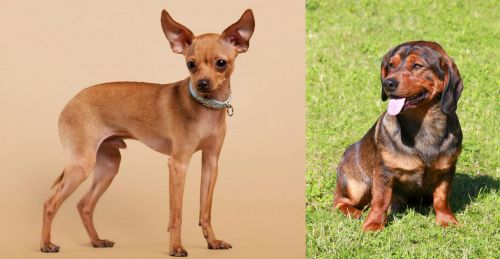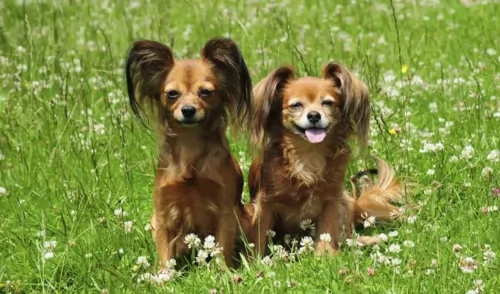 MyDogBreeds
MyDogBreeds Russian Toy Terrier is originated from Russia but Alpine Dachsbracke is originated from Austria. Russian Toy Terrier may grow 12 cm / 4 inches shorter than Alpine Dachsbracke. Russian Toy Terrier may weigh 15 kg / 33 pounds lesser than Alpine Dachsbracke. Both Russian Toy Terrier and Alpine Dachsbracke has almost same life span. Both Russian Toy Terrier and Alpine Dachsbracke has almost same litter size. Russian Toy Terrier requires Low maintenance. But Alpine Dachsbracke requires Moderate maintenance
Russian Toy Terrier is originated from Russia but Alpine Dachsbracke is originated from Austria. Russian Toy Terrier may grow 12 cm / 4 inches shorter than Alpine Dachsbracke. Russian Toy Terrier may weigh 15 kg / 33 pounds lesser than Alpine Dachsbracke. Both Russian Toy Terrier and Alpine Dachsbracke has almost same life span. Both Russian Toy Terrier and Alpine Dachsbracke has almost same litter size. Russian Toy Terrier requires Low maintenance. But Alpine Dachsbracke requires Moderate maintenance
 The Russian Toy Terrier is one of the dog breeds that hails from Russia in the 20th century. The Russian nobility fancied these little dogs as companions but also as they were useful for catching rats and being watchdog.They would set off an alarm with their barking.
The Russian Toy Terrier is one of the dog breeds that hails from Russia in the 20th century. The Russian nobility fancied these little dogs as companions but also as they were useful for catching rats and being watchdog.They would set off an alarm with their barking.
It is believed that the Manchester Terrier and the English Toy Terrier were the foundation breeds for this dog.
They are available in smooth and long-haired varieties. The breed has recently been recognized by the UK Kennel Club but is not yet recognized by the American Kennel Club.
 They are aggressive enough for hunting and tracking large animals as well as small, but they are gentle enough to bring an injured animal back to the hunter without hurting it more.
They are aggressive enough for hunting and tracking large animals as well as small, but they are gentle enough to bring an injured animal back to the hunter without hurting it more.
At one time the breed was a crown favorite, accompanying Prince Rudolph of Habsburg on his hunting excursions. The Alpine Dachsbracke is still a favorite hunting breed but is now more often found as a family pet.
 The Russian Toy Terrier is a petite dog and is inclined to be a fragile dog breed. It belongs to the toy group. It is also known as the Russian Toy Terrier or the Russkiy Toy.
The Russian Toy Terrier is a petite dog and is inclined to be a fragile dog breed. It belongs to the toy group. It is also known as the Russian Toy Terrier or the Russkiy Toy.
The dog’s small size means it is ideal for living in the city or the countryside.
He measures between just 20 and 28cm and weighs between just 1kg and 3kg.
The dog has a small head with big eyes and ears which are large ad erect. The tail was always traditionally docked to give it a cute, compact look, but these days it is left long.
You also get a long-coated dog and the smooth coated dog. The long coated variety has a lot of feathering around the tail, legs and ears. Colors of the coat can be solid red, brown and tan, black and tan or greyish and tan.
This little dog is full of character and is bold and cheerful. He is such a loyal, devoted little dog and small though he is he is territorial, protecting and guarding his owner. It is such a sociable little dog, devoted to his human family, while being wary of strangers.
Even a small dog like this will need training and socialization as he can become yappy and clingy if he is constantly piked up and petted.
 The Alpine Dachsbracke is a short, stocky dog with a long body and short legs. It is big boned and robust with round eyes. It has black toenails and a short, dense red or black coat.
The Alpine Dachsbracke is a short, stocky dog with a long body and short legs. It is big boned and robust with round eyes. It has black toenails and a short, dense red or black coat.
The bridge of his nose is straight with a strong muzzle. Its forehead has a well defined furrow and black lips and nose. He is muscular and his chest is broad and deep. He holds his tail high and has a trotting gait.
 The Russian Toy is a small, feisty dog with long legs and huge upright ears. He is intelligent too. Don't let his fine structure deceive you as he is far more robust and tough than he looks.
The Russian Toy is a small, feisty dog with long legs and huge upright ears. He is intelligent too. Don't let his fine structure deceive you as he is far more robust and tough than he looks.
He is a great playmate for disciplined, respectful children who know how to be kind to animals. Wild, unruly kids could so easily accidentally break one of his tiny little legs during rough play.
He loves his human family though and is guaranteed to make you an excellent little pet and companion.
 The Alpine Dachsbracke is a very lovable family dog even though he was bred to hunt and scent. They are great with kids and at their size are still good apartment, inside dogs. Though they need daily exercise they don’t need a large fenced in yard.
The Alpine Dachsbracke is a very lovable family dog even though he was bred to hunt and scent. They are great with kids and at their size are still good apartment, inside dogs. Though they need daily exercise they don’t need a large fenced in yard.
They are brave, intelligent and with a lot of stamina for the hunt or the walk. Take them on a hunting trip and they will adore you for it. Though they have plenty of power and endurance, they are not aggressive. However they are fearless and proud and need a strong pack leader for their human companion.
 There isn’t too much information about inherited health problems with this dog and he can live to be 11, 12 or 13 years of age, maybe even longer.There are one or two health problems to be aware of -
There isn’t too much information about inherited health problems with this dog and he can live to be 11, 12 or 13 years of age, maybe even longer.There are one or two health problems to be aware of -
This condition occurs with the knee caps of the dog and either one or both back legs can be affected. Sometimes surgery will be required to help the dog.
Little dogs always battle with their teeth, and the Russian Toy Terrier can experience problems when the puppy or ‘milk’ teeth don’t fall out. It affects the development of adult teeth. Sometimes the vet even has to have the teeth removed.
 They were bred to hunt and so are active dogs needing daily exercise and long walks.
They were bred to hunt and so are active dogs needing daily exercise and long walks.
They are at risk for back problems being long-backed dogs. The most common type of back problem is Intervertebral Disc Disease. This can cause pain and paralysis and can be caused by jumping, obesity or intense exercise.
 The Russian Toy Terrier is a small breed and isn’t going to need too much exercise. However it will do him good to get out to sniff around, and a walk every day will be recommended.
The Russian Toy Terrier is a small breed and isn’t going to need too much exercise. However it will do him good to get out to sniff around, and a walk every day will be recommended.
Your Russian Toy Terrier is a fairly low maintenance dog and isn’t going to require specialist grooming. The little dog will simply require some occasional brushing to remove loose hair.
When you brush him, check inside his mouth for bad teeth as small dogs like this can suffer from pain with overcrowding of teeth.
Tiny though he is, the Russian Toy Terrier will need good food. It will be tempting to pop sugary treats into such a tiny little dog’s mouth. This can in fact be seriously dangerous for him, not to mention that he can become obese. This opens up anew set of health problems.
You can feed this little dog commercially manufactured food but it should be the best quality one for small breeds.
Give him some tasty homemade food too. Simply add into one big pot chicken, brown rice or pasta and spinach, sweet potatoes and carrots. This food can all be chopped up, refrigerated and added warmed up and in small portions to your tiny pets dry kibble once or twice a week.
A tiny bit of raw meat can also go a long way to ensuring his skin stays healthy and free of skin infections.
Ensure that there is always a bowl of fresh, cool water within his reach.
 Whether a puppy or adult the breed is subject to obesity and needs to be fed a good, vitamin filled dry dog food. At the same time they need the calories if they are active or hunting.
Whether a puppy or adult the breed is subject to obesity and needs to be fed a good, vitamin filled dry dog food. At the same time they need the calories if they are active or hunting.
About one quarter to one half cup twice a day.
About one half cup twice a day until they become seniors or less active then reduce to a fourth of a cup twice a day.
The Alpine Daschbracke was bred to work. He needs exercise at least a couple times a day.
This breed is playful and loves to find and retrieve. Daily exercise is essential.